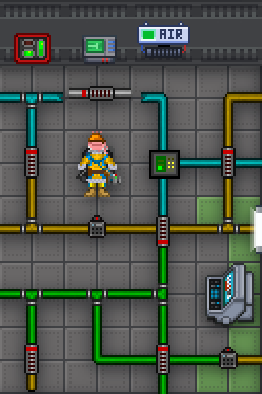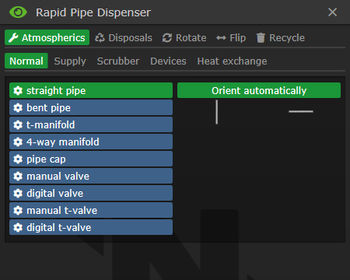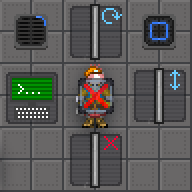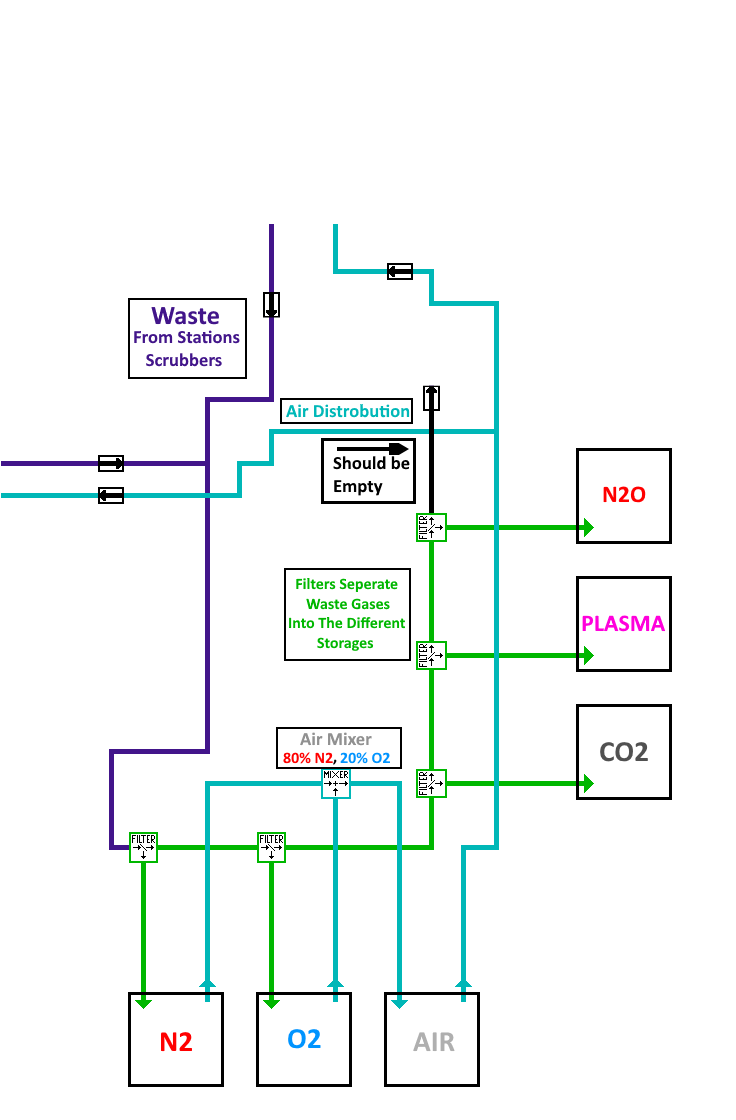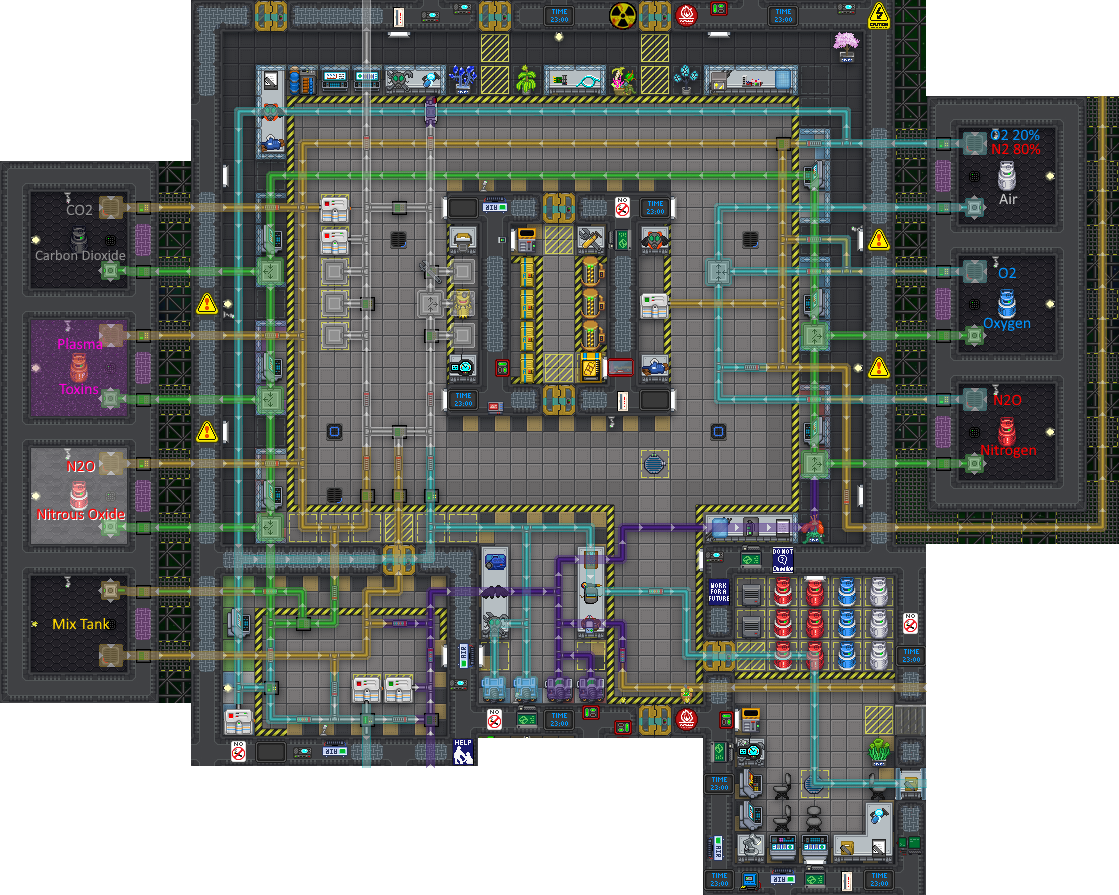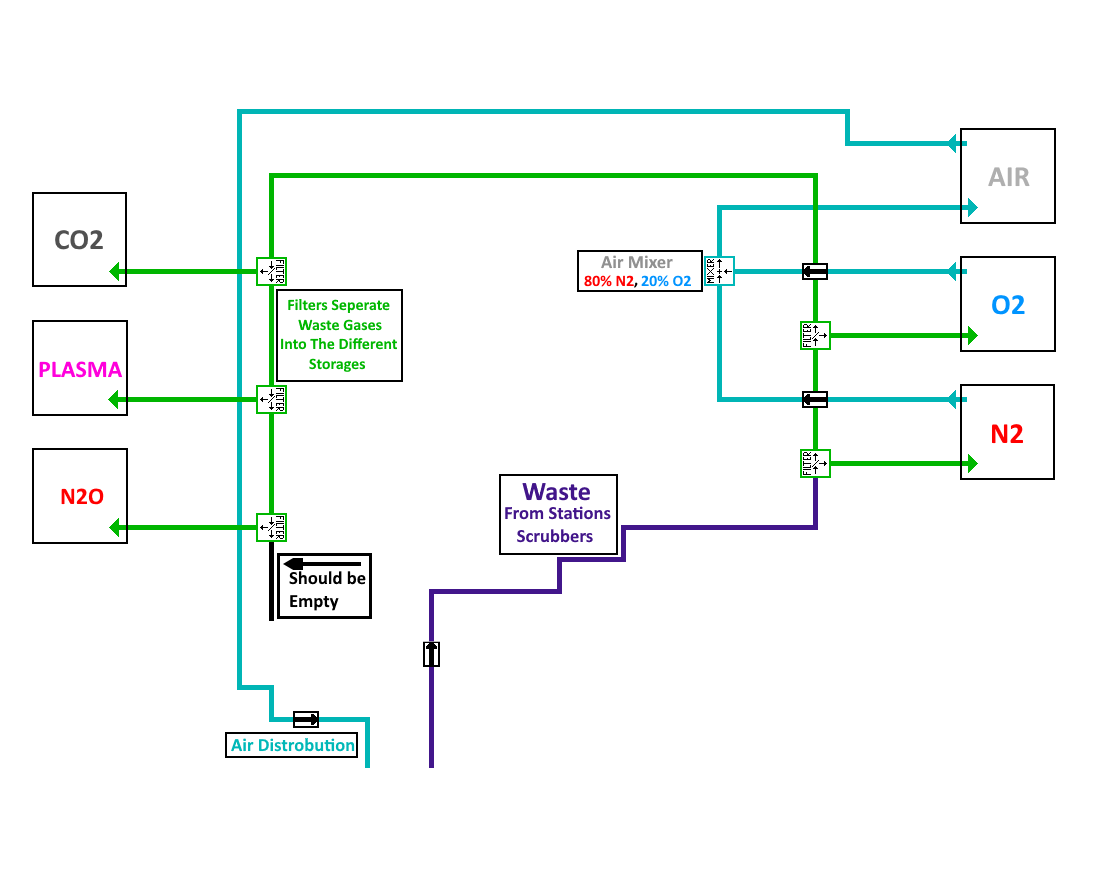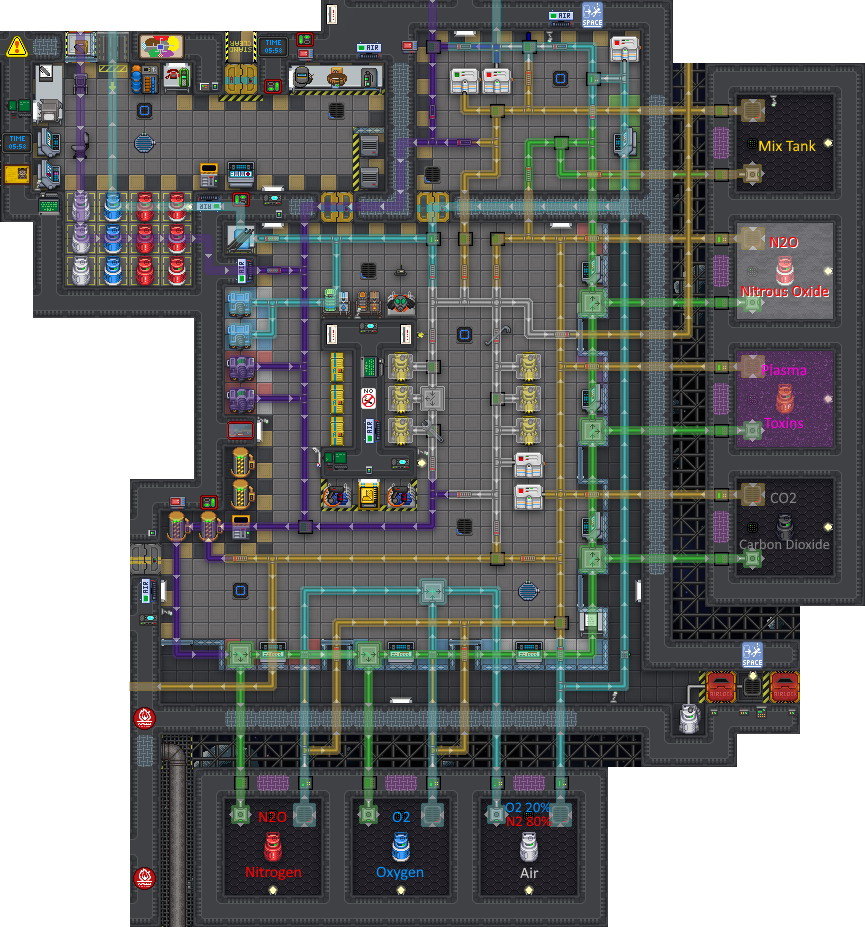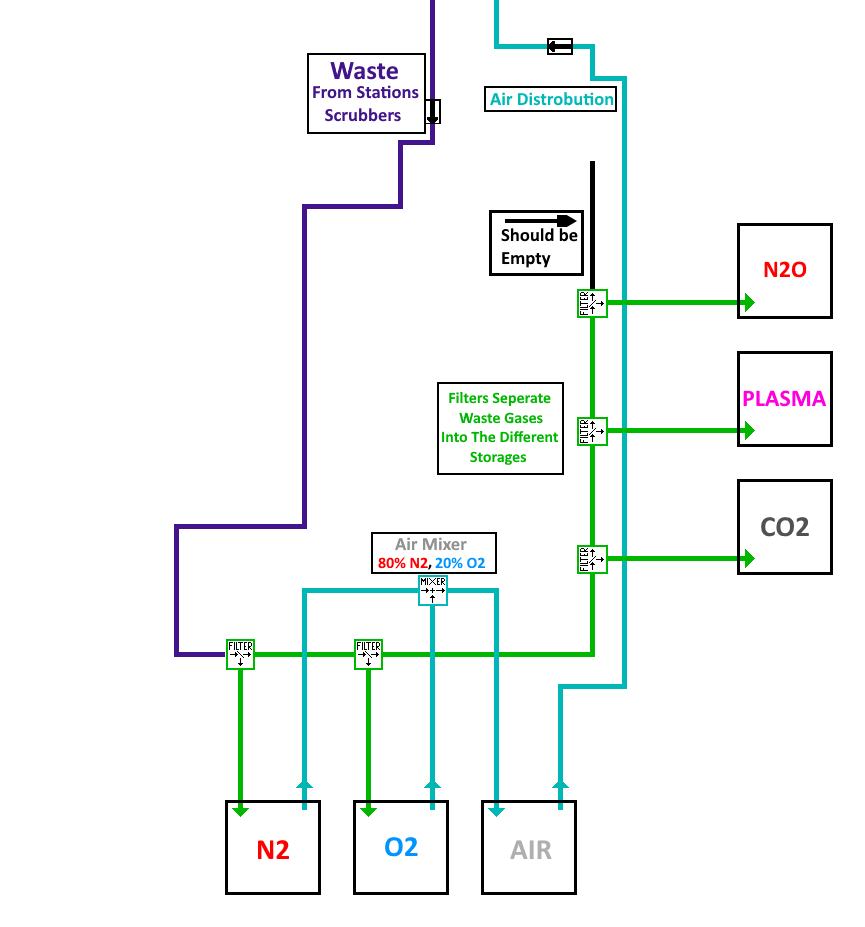Difference between revisions of "User:Krossarn"
(Blanked the page) Tag: Blanking |
|||
| (9 intermediate revisions by the same user not shown) | |||
| Line 1: | Line 1: | ||
{{JobEngineering}} | |||
[[Guide to Atmospherics]] | |||
Welcome to '''Atmospherics'''. Considered by many as one of the most diffcult profession to master on the station, while also being one of the most dangerous. | |||
The learning curve of Atmospherics is rather steep, its important to be patient and not losing focus. An Atmospheric Technician should be able to handle a few situations: | |||
Setting up Atmospherics properly, repressurise a room, remove dangerous gases in unwanted areas, mix and transport gases. | |||
The jobs main focus is of course around the various gases found on the station. | |||
The Atmospheric Technician should know how the different gases works and how to manipulate them for the saftey of the station and for their own little projects. | |||
Having proper knowledge over the pipes and devices is key for managing the gases. | |||
Working as an Atmospheric Technician can go from having a calm shift while working on a project or the station goal; | |||
into having to fix multiple breaches, repressurise several areas and fight fires all over the station, all at the same time. | |||
Knowledge over how to fix atmospheric issues is a must to ease the working condition for the rest of the crew. | |||
==The Basics Of Atmospherics== | |||
The first thing the technician need to understand is how to use the different available equipment to manipulate the atmospheric gases. | |||
Tools and pipes are ever so important to even begin working with the basics of atmospherics. | |||
===Atmospherics Tools=== | |||
[[File:Atmos_Tech_Working.png|right|frameless|thumb]] | |||
{| class="wikitable sortable mw-collapsible" width="74%" style="text-align: center; background-color: #fffcec;" | |||
|- style="font-weight: bold; background-color: #ffc050; color: white;" | |||
| style="width: 20%;" | Item | |||
| class="unsortable" style="width: 80%;" | Description | |||
|- | |||
! Rapid Pipe Dispenser{{anchor|Rapid Pipe Dispenser}} <br> [[File:Rapid_pipe_dispenser.png]] | |||
| A handheld tool that can print, place and recycle pipes. Fits in a backpack or coat and doesn't need ammo. | |||
|- | |||
! ATMOS Holofan{{anchor|ATMOS Holofan Projector}} <br> [[File:Engineering_Holofan_Projector.gif]] | |||
| Can project up to 3 holographic barriers which block gas movement. These holofans can be used to isolate breaches or prevent a spill from getting worse. Does not hold in high temperatures or in fires. | |||
|- | |||
! Analyzer{{anchor|Analyzer}} <br> [[File:Analyzer.png]] | |||
| Mostly used for scanning the surrounding air and measuring the gas content and composition of pipes and canisters. A [[PDA]] with the breathe deep cartridge can also scan pipes and canisters. | |||
|- | |||
! Multitool{{anchor|Multitool}} <br> [[File:Multitool.png]] | |||
| The multitool is used for many things. But for the atmospheric technician it's mostly used to link devices to monitors or an [[Air Alarm|air alarm]]. | |||
|- | |||
|} | |||
---- | |||
====Rapid Pipe Dispenser==== | |||
[[File:Rapid_Part_Dispenser_Menu.png|frameless|right|thumb|350px]] | |||
The Rapid Pipe Dispenser, aka RPD for short, will be one of the main tools for the technician to use. | |||
This device can rapidly dispense atmospherics and disposals piping, manipulate loose piping, and recycle any detached pipes it is applied to. | |||
There are five main tabs and five sub tabs in the RPDs menu where pipe types and pipe shapes can be selected as well as different pipe manipulations actions. | |||
[[File:Rapid_Part_Dispenser_Hud.png|right|frameless|thumb]] | |||
*'''Atmospherics''' - Have five sub tabs: | |||
**'''Normal''' - Consists of the type of pipe found in Atmospherics. | |||
**'''Supply''' - <span style="color:#0000B2">The dark blue pipes</span> used for the air distribution system. | |||
**'''Scrubber''' - <span style="color:#B70000">The red pipes</span> used for the scrubber system. | |||
**'''Devices''' - Holds all the usable devices. | |||
**'''Heat exchange''' - Have the type of pipes that will exchange heat with the atmosphere. | |||
*'''Disposals''' - Contains all the disposal type pipes and devices. | |||
*'''Rotate''' - Rotate the pipes and devices. | |||
*'''Flip''' - Invert the pipes and devices. | |||
*'''Recycle''' - Remove unwrenched pipes and devices. | |||
It can also select which direction the pipe will be facing or have it orient automatically. | |||
''Alt + left'' clicking the RPD will bring up a small hud which can be used to switch rapidly between UI, rotate, flip and delete. | |||
---- | |||
===Atmospherics Pipes=== | |||
There are a few different types of pipes on the station that the atmospheric technician will work with during their shift. They all can take every available type of gas. They are more used to better organize the pipe system overall. | |||
====Standard Pipes==== | |||
{| class="wikitable sortable mw-collapsible" width="90%" style="text-align: center; background-color: #fffcec;" | |||
|- style="font-weight: bold; background-color: #ffc050; color: white;" | |||
| style="width: 10%;" | Item | |||
| class="unsortable" style="width: 35%;" | Description | |||
| style="width: 10%;" | Item | |||
| class="unsortable" style="width: 35%;" | Description | |||
|- | |||
!Normal Pipes <br> [[File:Atmospheric_Pipe.png]] | |||
|Generic pipes that can be used for most tasks. These are airtight pipes that can carry any gas you pump into them. | |||
!Air Supply Pipe <br> [[File:supply_pipe.png|64px]] | |||
|Special pipes that are mostly used for the air distribution network. Can be laid in parallel to normal pipes and scrubber pipes. Used to distribute air all across the station. | |||
|- | |||
!Scrubber Pipes <br> [[File:scrubber_pipe.png]] | |||
|Special pipes that are mostly used for the waste network. Can be laid in parallel to normal pipes and air supply pipes. Used to move waste or harmful gases. | |||
!Heat Exchange Pipes <br> [[File:heat_exchanger_pipe.png|64px]] | |||
|Exchanges heat between any gas in the pipe and any gas in the tile. Think space loop(for cooling) or the [[Toxins]] burn chamber(for heating). Connects to normal pipes via junctions. | |||
|- | |||
!Universal Pipes <br> [[File:universal_pipe.png]] | |||
|Used to interface between normal, air supply, and scrubbers pipes. They cannot connect to each other without this. | |||
| colspan="2" | | |||
|} | |||
====Devices==== | |||
{| class="wikitable sortable mw-collapsible" width="90%" style="text-align: center; background-color: #fffcec;" | |||
|- style="font-weight: bold; background-color: #ffc050; color: white;" | |||
| style="width: 10%;" | Item | |||
| class="unsortable" style="width: 35%;" | Description | |||
| style="width: 10%;" | Item | |||
| class="unsortable" style="width: 35%;" | Description | |||
|- | |||
!Unary Vent <br> [[File:Vent_Port.png]] | |||
|The standard vent used to distribute air. Needs to be inside a blueprinted room with a functional air alarm to operate. Typically used to pump breathable air into a room. | |||
!Air Scrubber <br> [[File:Scrubber_Port.png]] | |||
|Scrubs the air clean. Needs to be inside a blueprinted room with a functional air alarm to operate. Can remove specific gases from the room it is in, or rapidly siphon out all gas. Typically used to remove harmful gases like CO2 from the station's air. | |||
|- | |||
!Passive Vent <br> [[File:Vent_Port.png]] | |||
|An unpowered vent that relies on pipe pressure to operate. Freely exchanges gas and heat between the tile and the connected pipe network, based on pressure and temperature gradients. Does not require power, or even a blueprinted room. | |||
!Dual-Port Air Vent <br> [[File:dual_vent.png]] | |||
|Has a valve and pump attached to it. There are two ports. | |||
|- | |||
!Connector Port <br> [[File:Connector_Port.png]] | |||
|A connector port for canisters of gas. Connects canisters to pipe networks. When used in conjunction with pumps, allows you to fill canisters or to empty them into a pipe network. | |||
!Gas Pump <br> [[File:Pump.png]] | |||
|A generic pressure pump. This pump is configured to measure how much gas it pumps by pressure. Can be set to only pump a certain amount of pressure through. The maximum pressure this pump can be set to move is 4500 kPa | |||
|- | |||
! Volume Pump <br> [[File:Volumetric_Pump.png]] | |||
|This pump is configured to measure how much gas it pumps by volume instead of pressure. Can be set to pump only a specific volume of gas through. The maximum volume this pump can be set to move is 200L/s. | |||
!Passive Gate <br> [[File:Passive_Gate.png]] | |||
|A valve that only lets gas through if it the input pressure and the output setting are both higher than the output pressure. Can be set to limit its output between 0 and 4500 kPa. | |||
|- | |||
!Gas Filter <br> [[File:Gas_Filter.png]] | |||
|A scrubber in pipe form. Checks for whatever gas you set it to, then filters it out into another pipe. | |||
!Gas Mixer <br> [[File:Gas_Mixer.png]] | |||
|The opposite of a filter. Takes the contents of its two inputs and combines them together at whatever ratio you tell it to, then pumps them through the output. Importantly, ratios are measured by pressure, not volume. Maximum output pressure is 4500 kPa | |||
|- | |||
!Heat Exchanger <br> [[File:Heat_exchanger.png]] | |||
|When two heat exchangers are placed next to each other, facing each other, they will try to equalize the heat between the two pipe networks they are connected to. They connect to normal pipes and thus are not part of the heat exchanger pipe system. | |||
!Air Injector <br> [[File:Air_Injector.png]] | |||
|A gas injector that will continue to pump its contents out regardless of how high the pressure around it is. Measures how much it pumps by volume. Will not operate without being linked to a console. Will display a green light when on. | |||
|- | |||
!Manual Valve <br> [[File:Manual_Valve.png]] | |||
|A manually-controlled valve, it requires no power and also no ID authorization to use. Doesn't require power(or a blueprinted room), doesn't require ID access, and cannot be operated by the AI, borgs, or drones. Displays a small green light when open. | |||
!Digital Valvle <br> [[File:Digital_Valve.png]] | |||
|An electronically-controlled gas valve. Requires power, requires ID access, and can be operated by the AI, borgs, and drones. Displays a small green light when open. | |||
|- | |||
!Meter <br> [[File:meter.gif]] | |||
|Simply place over any flat stretch of pipe and wrench it on. Upon examination, it should now be yielding measurements on what is going on inside the pipe. Does not provide as much information as an analyser/gas scanner, but good for being able to tell what is going on at a glance. | |||
!Gas Sensor <br> [[File:Gas_Sensor.png|64px]] | |||
|Used to sense the pressure and temperature of the gas surrounding the sensor itself, rather than a pipe. Must be connected to one of several kinds of computer to be used. | |||
|- | |||
|} | |||
====Disposal Pipes==== | |||
{| class="wikitable sortable mw-collapsible" width="90%" style="text-align: center; background-color: #fffcec;" | |||
|- style="font-weight: bold; background-color: #ffc050; color: white;" | |||
| style="width: 10%;" | Item | |||
| class="unsortable" style="width: 35%;" | Description | |||
| style="width: 10%;" | Item | |||
| class="unsortable" style="width: 35%;" | Description | |||
|- | |||
! Disposal Pipe <br> [[File:Disposal_pipe.png]] | |||
| Large pneumatic pipes that are used to carry trash, mail, and occasionally people around the station. | |||
! Disposal Bin <br> [[File:Disposal_bin.png]] | |||
| The preferred method for delivering garbage into disposal pipes. Holds onto contents until they are flushed, whether manually or automatically. | |||
|- | |||
! Disposal Outlet <br> [[File:Disposal_outlet.png]] | |||
| Whenever something or someone has reached this from a disposal pipe, they are ejected after a buzzer sounds. | |||
! Disposal Intake <br> [[File:Disposal_intake.png]] | |||
| An open chute into disposal pipes. Objects or people that enter will be sent into connected disposal pipes. Objects or people who reach one of these at the end of a disposal pipe are ejected at high speed in a random direction. | |||
|} | |||
===Gases=== | |||
The main goal of atmospherics is to manipulate these in a way that benefits the station. Each type of gas has different properties that can help or hinder. Your skill in manipulating these will determine the success of your atmospheric machinations. | |||
{| class="wikitable sortable mw-collapsible" width="90%" style="text-align: center; background-color: #fffcec;" | |||
|- style="font-weight: bold; background-color: #ffc050; color: white;" | |||
| style="width: 15%;" | Item | |||
| class="unsortable" style="width: 75%;" | Description | |||
|- | |||
! Nitrogen (N2) <br> [[File:N2_canister.png]] | |||
| Nitrogen is an inert gas that makes up 80% of the air on the station. Vox breathe this. But in the station atmosphere, it mostly just takes up space. | |||
|- | |||
! Oxygen (O2) <br> [[File:O2_canister.png]] | |||
| The other 20% of the air. Filling the entire station with O2 would work but is worthless and makes it a even bigger firehazard. Most of the crew will be needing at least 16kPa of this stuff in the atmosphere in order to live. So filling the entire station with O2 would work but is worthless and makes it an even bigger firehazard. Poisonous to Vox and Plasmamen. Necessary for burning plasma. | |||
|- | |||
! Air <br> [[File:Air_Canister.png]] | |||
| You know what this is. The gas mix that is distributed around the station. It is composed of 80% N2 and 20% O2. | |||
|- | |||
! Carbon Dioxide (CO2) <br> [[File:CO2_canister.png]] | |||
| An invisible gas that is slightly heavier than air. This is what crewmembers who breathe will be exhaling. Also produced by plasma fires. In high concentrations, will make you pass out, which can quickly lead to suffocation. | |||
|- | |||
! Nitrous Oxide (N2O) <br> [[File:N2O_canister.png]] | |||
| Also known as Sleeping Agent. A white-flecked gas that is slightly heavier than CO2. At low concentrations, will cause sporadic laughing. At high concentrations, will put you to sleep. | |||
|- | |||
! Toxins (Plasma) <br> [[File:Plasma_canister.png]] | |||
| The oil of the new world. Purple, highly flammable, and highly toxic(unless you are a Plasmaman). Burns with oxygen and will spontaneously ignite with it at a high enough temperature. Much heavier than all the previous gases. | |||
|} | |||
==Atmospherics== | |||
The main room for this sub-department. Not everyone will use this room to it's fullest extent. But as one of the biggest areas on the station the possibilities are endless. The room might look scary at first sight, but it's rather straightforward. Everything will function without properly setting up atmospherics at the start of the shift; the station will be supplied with air and filter out waste without crew interference. But it's higly recommended to do so. | |||
Atmospherics is built in such a way so that new technicians will quickly learn how the room works. And to easier see what pipes and devices do what; the room uses colour coded pipes. | |||
===Colour Coded Pipes=== | |||
At first glance it might look silly having pipes in different colours. But by doing so it's easier to distinguish what section of the pipenet does what. As one wise Atmospherics Technician once said "Stare at it until it make sense."; follow this advice and it will all become clear in due time. | |||
{| class="wikitable sortable mw-collapsible" width="90%" style="text-align: center; background-color: #fffcec;" | |||
|- style="font-weight: bold; background-color: #ffc050; color: white;" | |||
| style="width: 10%;" | Item | |||
| class="unsortable" style="width: 35%;" | Description | |||
| style="width: 10%;" | Item | |||
| class="unsortable" style="width: 35%;" | Description | |||
|- | |||
!Air Supply <br> [[File:supply_pipe.png]] | |||
|The '''<span style="color:#0000B2">dark blue pipe</span>''' is the '''<span style="color:black">Main Air Supply</span>'''. It sends breathable air (roughly 80% nitrogen and 20% oxygen) to all the vents on the station, and is fed by the cyan pipe in Atmospherics. | |||
!Scrubber <br> [[File:Scrubber_pipe.png]] | |||
|The '''<span style="color:#B70000">red pipe</span>''' is the '''<span style="color:black">Scrubber Pipe</span>'''. This is where all the toxic waste normally ends up by the scrubber system found all around the station. It may contain breathable air, however it is unfiltered and possibly contaminated. | |||
|- | |||
!Air Mix <br> [[File:cyan_pipe.png]] | |||
|The '''<span style="color:#00B2B2">cyan pipe</span>''' is the breathable air or the '''<span style="color:black">Air Mix</span>'''. This pipe feeds into the main air supply. | |||
!Waste <br> [[File:purple_pipe.png]] | |||
|The '''<span style="color:#42168B">purple pipe</span>''' is the '''<span style="color:black">Waste Pipe</span>''', which retrieves waste air from the scrubber pipe which then leads to the filter. | |||
|- | |||
!Filter <br> [[File:green_pipe.png]] | |||
|The '''<span style="color:#00B800">green pipe</span>''' is the '''<span style="color:black">Filter Pipe</span>''', which filters out the various gases in the waste air provided by the water at various filters placed along it. Each filter puts the respect gases back into the gas containers. | |||
!Pure <br> [[File:yellow_pipe.png]] | |||
|The '''<span style="color:#B79200">yellow pipe</span>''' is the '''<span style="color:black">Mix Pipe</span>''', which is internal to Atmospherics and is used for custom air mixes. | |||
|} | |||
===Atmospherics Layout=== | |||
<tabs> | |||
<tab name="NSS Cyberiad"> | |||
The layout of NSS Cyberiad, aka Boxstation. <br> | |||
[[File:Atmos_Box_Highlighted.png]] | |||
</tab> | |||
<tab name="NSS Cyberiad Simplified"> | |||
A Simplified version of NSS Cyberiads Air distrobution system. <br> | |||
[[File:Atmos_Box_Simplified.png]] | |||
</tab> | |||
<tab name="NSS Kerberos"> | |||
The layout of NSS Kereberos, aka Deltastation. <br> | |||
[[File:Atmos_Delta_Highlighted.png]] | |||
</tab> | |||
<tab name="NSS Kerberos Simplified"> | |||
A Simplified version of NSS Kereberos Air distrobution system. <br> | |||
[[File:Atmos_Delta_Simplified.png]] | |||
</tab> | |||
<tab name="NSS Cereberon"> | |||
The layout of NSS Cereberon, aka Metastation. <br> | |||
[[File:Atmos_Meta_Highlighted.png]] | |||
</tab> | |||
<tab name="NSS Cereberon Simplified"> | |||
A Simplified version of NSS Cereberon Air distrobution system. <br> | |||
[[File:Atmos_Meta_Simplified.png]] | |||
</tab> | |||
</tabs> | |||
===Mixing Gases=== | |||
====Gas For Canisters==== | |||
====Gas For The Turbine==== | |||
====Gas For The Supermatter==== | |||
==Station Systems== | |||
There are some systems on the station that the atmospheric technician will be working with during their shift. | |||
===[[Air Alarm|Air Alarms]]=== | |||
[[File:AirAlarm.png]] | |||
Mandatory for the use of non-passive vents and scrubbers. Allows a wide range of control over a blueprinted rooms current gas contents. Where exactly the Air Alarm is in the room does not matter. As long as the room is blueprinted and powered it will function. Cannot be placed in areas that are not blueprinted. | |||
'''To learn more about Air Alarms and how to use them, click here: [[Air Alarm]]''' | |||
---- | |||
===Fire Alarms=== | |||
[[File:FireAlarm.png]] | |||
Most areas have firelock doors which close if a fire is detected. This will stop the fire from spreading to other areas and is therefore very useful. Some crewmembers can be tempted to force them open (by resetting the fire alarm for the area) without one thought that doing so provides the fire with more oxygen, which will keep it burning longer. | |||
---- | |||
<br><br> | |||
===Computer Consoles And Monitors=== | |||
{| class="wikitable sortable mw-collapsiblewidth="90%" style="text-align: center; background-color: #fffcec;" | |||
|- style="font-weight: bold; background-color: #ffc050; color: white;" | |||
| style="width: 15%;" | Computer | |||
| style="width: 75%;" | Description | |||
|- | |||
!Central Atmospherics <br> Computer <br> | |||
[[File:atmos_tank_monitor.png|center]] | |||
|The most important computer for the Atmospherics department to have. It can remotley access all air alarms on the station. Can also show a map with locations of all the air alarms. | |||
|- | |||
!Atmospheric Alert <br> Computer <br> | |||
[[file:atmos_alert_console.gif|center]] | |||
|This computer will tell you where your attention is needed. Green means everything is alright, yellow signals something is wrong, and red means things have gone wrong enough for an alarm to be triggered (Usually caused when a room's air stops being breathable). | |||
|- | |||
!Large Tank <br> Control <br> | |||
[[File:atmos_tank_monitor.png|center]] | |||
|Can be used to monitor the pressure and control the inlet and outlet of larger tanks in Atmospherics. This computer is needed to be able to use the Injector. | |||
|- | |||
!Tank Monitor <br> | |||
[[File:atmos_tank_monitor.png|center]] | |||
|Just like the Large Tank Control but will only connect to sensors, making it rather obsolete. | |||
|} | |||
<br> | |||
====Link Devices To Monitors==== | |||
[[File:Link_Device.png|right|thumb]] | |||
To link different atmospheric devices, such as the air injector, a multitool is required. By using the multitool on the device a window will appear that will show what '''Frequency''' it's using, what it's named with an '''ID tag''' and the '''Multitool Buffer''' that links the device to the multitool. Not every device will have the option to add it to a multitool and some don't need to be added to a multitool at all. | |||
<br><br> | |||
The gas sensor have a few option on what information to show by enabling the different internal sensors with the multitool. | |||
<br><br> | |||
With the device added to the multitool it is now possible to link it to preferably a Large Tank Control. Use the multitool on the computer and a new window will appear. <br><br> | |||
'''Frequency''' needs to be the same as the device for it to be able to link at all. | |||
'''Input''' is where an air injector or unary vent can be linked with. | |||
'''Output''' is for the unary vent with the siphon mode enabled. | |||
'''Sensors''' only require to be on the same frequency to be linked to the gas sensor. | |||
---- | |||
===Atmospherics Machinery=== | |||
Some machinery are of use when working with atmospherics. Luckily enough theres not as many as devices. | |||
====Thermomachines==== | |||
[[File:Freezer.gif|left]] Also known as "Heaters" or "Freezers". They can be use to either heat och cool gas in the pipe it's directly connected to. Upgrading it with lasers will increase maximum and minimum temperature available; upgrading with matter bins will decrease the time needed to reach the desired vaule. | |||
Useful in many senarios: such as help a basic [[Thermoelectric Generator|TEG]] to produce power so the completion of the station goal [[Station Goals#Bluespace Harvester|BSH]] can be made possible, or cooling down a gas to easier transport a large ammount of [[#Moles|moles]]. | |||
These are just some of many uses made possible by te thermomachine. | |||
---- | |||
===Atmospheric Portable Equipment=== | |||
{| class="wikitable sortable mw-collapsible" width="90%" style="text-align: center; background-color: #fffcec;" | |||
|- style="font-weight: bold; background-color: #ffc050; color: white;" | |||
| style="width: 15%;" | Item | |||
| style="width: 75%;" | Description | |||
|- | |||
!Space Heater <br> [[file:Space Heater.gif]] | |||
|Heating up a cold area. Find a nearby breach and turn it on once it's been repaired. Made by the Space Amish, it can reliably heat up a room to a habitable temperature. Can be adjusted. | |||
|- | |||
!Portable Pump <br> [[file:Portable Air Pump.gif]] | |||
|Filling a room with air or sucking the air out of a room. Set the pump direction to out, set the release pressure to maximum. Be sure to connect it to the blue-designated ports outside [[Engineering]] to fill it up with some delicious air-mix beforehand. Turn it on, and use it to carve the room's atmosphere to your desire. | |||
|- | |||
!Portable Scrubber <br> [[file:Portable Air Scrubber.gif]] | |||
|Cleaning the air from Plasma and other unwanted gasses. Can also used for emptying Plasma Tanks and Oxygen tanks. | |||
|} | |||
==Basic Atmospherics Mathematical Details== | |||
===Ideal Gas Law=== | |||
====Pressure==== | |||
====Volume==== | |||
====Moles==== | |||
====Temperature==== | |||
===Heat Capacity=== | |||
====Fire==== | |||
===Convertion To And From Kelvin=== | |||
==Disposals== | |||
===Understanding Disposals=== | |||
===Sort Junction And Destination Tagger=== | |||
==Additional Guides And Related Links== | |||
===Guides=== | |||
===Links=== | |||
Latest revision as of 08:24, 8 January 2023
Departmental Head
Chief Engineer
Welcome to Atmospherics. Considered by many as one of the most diffcult profession to master on the station, while also being one of the most dangerous. The learning curve of Atmospherics is rather steep, its important to be patient and not losing focus. An Atmospheric Technician should be able to handle a few situations: Setting up Atmospherics properly, repressurise a room, remove dangerous gases in unwanted areas, mix and transport gases.
The jobs main focus is of course around the various gases found on the station. The Atmospheric Technician should know how the different gases works and how to manipulate them for the saftey of the station and for their own little projects. Having proper knowledge over the pipes and devices is key for managing the gases.
Working as an Atmospheric Technician can go from having a calm shift while working on a project or the station goal; into having to fix multiple breaches, repressurise several areas and fight fires all over the station, all at the same time. Knowledge over how to fix atmospheric issues is a must to ease the working condition for the rest of the crew.
The Basics Of Atmospherics
The first thing the technician need to understand is how to use the different available equipment to manipulate the atmospheric gases.
Tools and pipes are ever so important to even begin working with the basics of atmospherics.
Atmospherics Tools
| Item | Description |
Rapid Pipe Dispenser 
|
A handheld tool that can print, place and recycle pipes. Fits in a backpack or coat and doesn't need ammo. |
|---|---|
ATMOS Holofan 
|
Can project up to 3 holographic barriers which block gas movement. These holofans can be used to isolate breaches or prevent a spill from getting worse. Does not hold in high temperatures or in fires. |
Analyzer 
|
Mostly used for scanning the surrounding air and measuring the gas content and composition of pipes and canisters. A PDA with the breathe deep cartridge can also scan pipes and canisters. |
Multitool 
|
The multitool is used for many things. But for the atmospheric technician it's mostly used to link devices to monitors or an air alarm. |
Rapid Pipe Dispenser
The Rapid Pipe Dispenser, aka RPD for short, will be one of the main tools for the technician to use. This device can rapidly dispense atmospherics and disposals piping, manipulate loose piping, and recycle any detached pipes it is applied to.
There are five main tabs and five sub tabs in the RPDs menu where pipe types and pipe shapes can be selected as well as different pipe manipulations actions.
- Atmospherics - Have five sub tabs:
- Normal - Consists of the type of pipe found in Atmospherics.
- Supply - The dark blue pipes used for the air distribution system.
- Scrubber - The red pipes used for the scrubber system.
- Devices - Holds all the usable devices.
- Heat exchange - Have the type of pipes that will exchange heat with the atmosphere.
- Disposals - Contains all the disposal type pipes and devices.
- Rotate - Rotate the pipes and devices.
- Flip - Invert the pipes and devices.
- Recycle - Remove unwrenched pipes and devices.
It can also select which direction the pipe will be facing or have it orient automatically.
Alt + left clicking the RPD will bring up a small hud which can be used to switch rapidly between UI, rotate, flip and delete.
Atmospherics Pipes
There are a few different types of pipes on the station that the atmospheric technician will work with during their shift. They all can take every available type of gas. They are more used to better organize the pipe system overall.
Standard Pipes
| Item | Description | Item | Description |
Normal Pipes 
|
Generic pipes that can be used for most tasks. These are airtight pipes that can carry any gas you pump into them. | Air Supply Pipe 
|
Special pipes that are mostly used for the air distribution network. Can be laid in parallel to normal pipes and scrubber pipes. Used to distribute air all across the station. |
|---|---|---|---|
Scrubber Pipes 
|
Special pipes that are mostly used for the waste network. Can be laid in parallel to normal pipes and air supply pipes. Used to move waste or harmful gases. | Heat Exchange Pipes 
|
Exchanges heat between any gas in the pipe and any gas in the tile. Think space loop(for cooling) or the Toxins burn chamber(for heating). Connects to normal pipes via junctions. |
Universal Pipes 
|
Used to interface between normal, air supply, and scrubbers pipes. They cannot connect to each other without this. | ||
Devices
Disposal Pipes
Gases
The main goal of atmospherics is to manipulate these in a way that benefits the station. Each type of gas has different properties that can help or hinder. Your skill in manipulating these will determine the success of your atmospheric machinations.
Atmospherics
The main room for this sub-department. Not everyone will use this room to it's fullest extent. But as one of the biggest areas on the station the possibilities are endless. The room might look scary at first sight, but it's rather straightforward. Everything will function without properly setting up atmospherics at the start of the shift; the station will be supplied with air and filter out waste without crew interference. But it's higly recommended to do so. Atmospherics is built in such a way so that new technicians will quickly learn how the room works. And to easier see what pipes and devices do what; the room uses colour coded pipes.
Colour Coded Pipes
At first glance it might look silly having pipes in different colours. But by doing so it's easier to distinguish what section of the pipenet does what. As one wise Atmospherics Technician once said "Stare at it until it make sense."; follow this advice and it will all become clear in due time.
Atmospherics Layout
Mixing Gases
Gas For Canisters
Gas For The Turbine
Gas For The Supermatter
Station Systems
There are some systems on the station that the atmospheric technician will be working with during their shift.
Air Alarms
Mandatory for the use of non-passive vents and scrubbers. Allows a wide range of control over a blueprinted rooms current gas contents. Where exactly the Air Alarm is in the room does not matter. As long as the room is blueprinted and powered it will function. Cannot be placed in areas that are not blueprinted.
To learn more about Air Alarms and how to use them, click here: Air Alarm
Fire Alarms
Most areas have firelock doors which close if a fire is detected. This will stop the fire from spreading to other areas and is therefore very useful. Some crewmembers can be tempted to force them open (by resetting the fire alarm for the area) without one thought that doing so provides the fire with more oxygen, which will keep it burning longer.
Computer Consoles And Monitors
| Computer | Description |
| Central Atmospherics Computer |
The most important computer for the Atmospherics department to have. It can remotley access all air alarms on the station. Can also show a map with locations of all the air alarms. |
|---|---|
| Atmospheric Alert Computer |
This computer will tell you where your attention is needed. Green means everything is alright, yellow signals something is wrong, and red means things have gone wrong enough for an alarm to be triggered (Usually caused when a room's air stops being breathable). |
| Large Tank Control |
Can be used to monitor the pressure and control the inlet and outlet of larger tanks in Atmospherics. This computer is needed to be able to use the Injector. |
| Tank Monitor |
Just like the Large Tank Control but will only connect to sensors, making it rather obsolete. |
Link Devices To Monitors
To link different atmospheric devices, such as the air injector, a multitool is required. By using the multitool on the device a window will appear that will show what Frequency it's using, what it's named with an ID tag and the Multitool Buffer that links the device to the multitool. Not every device will have the option to add it to a multitool and some don't need to be added to a multitool at all.
The gas sensor have a few option on what information to show by enabling the different internal sensors with the multitool.
With the device added to the multitool it is now possible to link it to preferably a Large Tank Control. Use the multitool on the computer and a new window will appear.
Frequency needs to be the same as the device for it to be able to link at all.
Input is where an air injector or unary vent can be linked with.
Output is for the unary vent with the siphon mode enabled.
Sensors only require to be on the same frequency to be linked to the gas sensor.
Atmospherics Machinery
Some machinery are of use when working with atmospherics. Luckily enough theres not as many as devices.
Thermomachines
Also known as "Heaters" or "Freezers". They can be use to either heat och cool gas in the pipe it's directly connected to. Upgrading it with lasers will increase maximum and minimum temperature available; upgrading with matter bins will decrease the time needed to reach the desired vaule.
Useful in many senarios: such as help a basic TEG to produce power so the completion of the station goal BSH can be made possible, or cooling down a gas to easier transport a large ammount of moles. These are just some of many uses made possible by te thermomachine.
Atmospheric Portable Equipment
| Item | Description |
Space Heater 
|
Heating up a cold area. Find a nearby breach and turn it on once it's been repaired. Made by the Space Amish, it can reliably heat up a room to a habitable temperature. Can be adjusted. |
|---|---|
Portable Pump 
|
Filling a room with air or sucking the air out of a room. Set the pump direction to out, set the release pressure to maximum. Be sure to connect it to the blue-designated ports outside Engineering to fill it up with some delicious air-mix beforehand. Turn it on, and use it to carve the room's atmosphere to your desire. |
Portable Scrubber 
|
Cleaning the air from Plasma and other unwanted gasses. Can also used for emptying Plasma Tanks and Oxygen tanks. |

